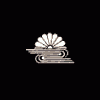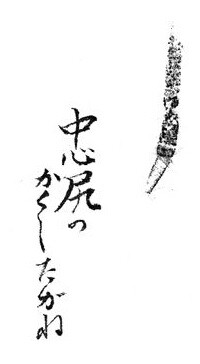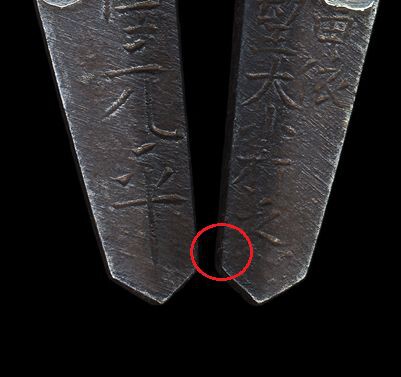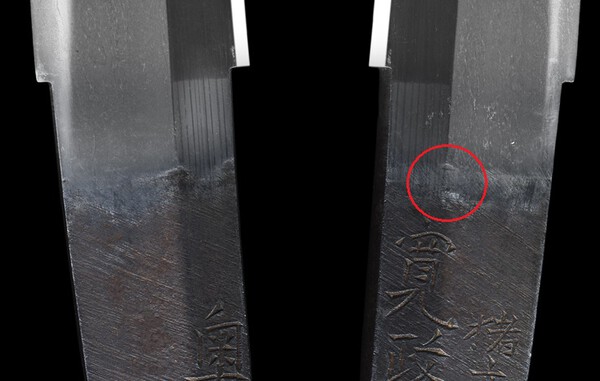-
Posts
936 -
Joined
-
Last visited
-
Days Won
24
Content Type
Profiles
Forums
Events
Store
Downloads
Gallery
Everything posted by Markus
-
Thank you Paul! I don´t want to rush in here just to advertize my books but the 30% off coupon of Lulu.com is now available up to Sunday 9th and there might be some "surprise offers" coming. Please see link below. http://www.lulu.com/home Sorry for my blunt advertising.
-
I would say yes, as I have seen several hozon-level papers for signed blades with supplements like kuni fumei (国不明, province unclear) but with at least vague datings like "late Muromachi period". So I interpret such papers as for unrecorded smiths (meikan-more, 銘鑑洩れ). Please take a look at the papers to these blades for example. http://www.e-sword.jp/sale/2011/1110_3012syousai.htm http://www.e-sword.jp/sale/2013/1310_3027syousai.htm But I´ve never seen and tokubetsu hozon paper of this kind. Would be interesting to be proven wrong. Also I would be eager to see an example of a paper which actually says "meikan-more".
-
It seems that there was no koto smith using these characters for "Moritoshi". Also I was unable to connect the family name "Hosokawa" to any of the Moritoshi found in the meikan records. So the smith is either meikan-more (not in the meikan lists), or there is always the possibility with ken that they bear the name of their donator if presented to a temple or shrine.
-
I read "Hosokawa Moritoshi" 細河盛俊 But only sure about the first three characters.
-
Update on the issue with the shinogi and the nakago-jiri: I was informed that at Motohira, the shinogi does not run directly into the tip of the kengyo-jiri as common for most smiths but runs out 2~3 mm at the side of that tip. It is not that obvious at the blade in question because the very end of the shinogi is not that crips, but I was told that at other Motohira blades, you can see that the shinogi does not end at the tip of the kengyo-jiri. Many thanks to the attentive reader!
-
@Chris: Its not found in the dictionaries and more one of those "unofficial" readings. But I have read it several times and for example the sword dealer Tonbo uses the characters with their reading "tonbo". http://kottou-tonbo.com/ As for the "katsumushi" reading, I used that one before but was told by a Japanese friend some years ago that I should avoid it and use "kachimushi" instead as it is the proper reading for the characters in question. However, he didn´t tell my if "katsumushi" is incorrect...
-
In the meanwhile I was contacted by someone who handled this very blade directly at Tsuruta in Japan. It seems that the person making the descriptions on the homepage mixed something up because the two tagane marks are exactly on the underside of the nakagojiri, i.e. only visible when holding the blade tip down. So we just have to forget about the "upper part of the nakago, one or two lines are engraved". I guess the person meant "upper face of the nakagojiri". That´s probably why this issue isn´t found at the Japanese site of Aoi Art. But regarding the shinogi issue, I am afraid I am not of much help in this respect as I haven´t heard of that peculiarity so far.
-
I think Peter refers to the other name of tonbo, kachimushi (勝虫), which means indeed literally "victory insect". By the way, the characters (勝虫) are often also just read "tonbo".
-
Tsuruta san provides a small oshigata of the nakago-jiri pointing out the kakushi-tagane. I guess on photo, it is the small notch we can see (circled in red). Regarding the two lines he mentions for the top part of the nakago, I must confess that I have no clue as I have never heard of them and they are also not address on the Japanese site of Aoi Art. My humble guess is what is circled in red in the pic below.
-
It is because it is paper as en suite set of fittings (soroi-kanagu, 揃金具). The same applies to papers for koshirae where the individual fittings also might be made/signed by different artists. Very interesting set by two contemporary kinko masters!
-
The Musashi Kunishige lineage split off from the Shitahara Yasushige group in 1617. The 1st gen. Musashi Kunishige was active around Kan´ei (寛永, 1624-1644), the 2nd around Manji (万治, 1658-1661), the 3rd around Genroku (元禄, 1688-1704), the 4th around Hōreki (宝暦, 1751-1764) and the 5th and last around Tenmei (天明, 1781-1789). There is a blade extant by the 2nd gen. on which he signed the title "Yamashiro no Kami" in hiragana syllables. Apart from that, only the 4th and 5th generations signed with "Yamashiro no Kami". The 3rd generation bore the title "Tajima no Kami".
-
Thank you all so far! I am getting a lot of feedback at the moment to also make available the other, i.e. the non sword-related sketches of Natsuo, quasi for the "real freaks" out there. Of course I will comply and will provide a hardcover book in the very same format and layout in the next couple of days (to stay within the CORNUCOPIA code). FYI: There are seven numbered and one unnumbered sketchbooks of Natsuo extant which contain altogether about 300 double-pages. PS: I really don´t know why I as the author never get any of those notifications about Lulu voucher codes...
-
Out now, the most comprehensive, non-Japanese book on Natsuo. Even though the kinko artist Kano Natsuo is on everyone´s lips when it comes to conversations about late Edo period sword fittings surprisingly little material is available outside of Japan, in neither a comprehensive or in a published form. With this publication I try to provide a remedy by introducing an outline of his career, his personality, his art, his students and his works (34 pieces on more than 50 pages). And, as a reference, I have republished all four of Natsuo’s sketchbooks on sword fittings (Kengu-shitazu-soko). Thus I hope that with this publication I can contribute to the understanding and appreciation of this great artist in the West and that the reader enjoys browsing through Natsuo´s sketches. Will surely also make a great Christmas present. 8.25 wide x 10.75 tall, full color, hardcover, 250 pages – $ 129.00 http://www.lulu.com/shop/markus-sesko/k ... 93656.html And the eBook is available here: http://www.lulu.com/shop/markus-sesko/e ... 93676.html
-

Out now: NIHON-SHINSHINTO-SHI
Markus replied to Markus's topic in General Nihonto Related Discussion
Thank you Gilles! Feedback like yours is what keeps me working. Much appreciated. -
The "problem" is, that the metezashi was worn edge down. So it was not like a tanto worn at the left hip pushed along the obi to the right hip. Thus it requires another kurigata and a kaerizuno.
-
I always understood this as more like a kind of "warning". I.e. in the sense when all the meikan agree that there are no tanto or whatever blades extant of a smith and you stumble over one, be cautious.
-
I was only able to find one reference, namely in Haynes, stating that "Tetsunin" was the pseudonym of Yukimori (H 12426.0), who made tsuba in the Saga Kaneie school style. Also Haynes writes: "His relationship to artists who signed Tetsunin (鉄人) is not known." But in the entry for Tetsunin (鉄人, H 09683.0) he writes: "Later some of this group signed Testunin (鉄仁) ... There were also other variations on this style of signature."
-
I might read "Tetsunin" 鉄仁
-
I can confirm that the sword on Aoi Art is the one from Tobi 619 is I featured the latter too in my Shinto & Shinshinto-kantei. I attach a PDF of the relevant pages. Korekazu.pdf
-
-
Never seen one of those either. What doesn´t give me a good feeling for this one is that it declares the Muramasa blade as preservable tôsôgu
-
It´s not really Nihonto related so I post this info in the translation section. This latest work is a guide for all those who are struggling with identifying cursive script (sôsho) characters in signaturey, may it be on tôsôgu, on paintings, vases, etc. As the usual "identifying by number of strokes" cannot be applied any longer, you have to go for the radicals. So this dictionary provides several examples of how each radical appears in its cursive writing. A match with the supposed radical of the cursive character takes you to the page which lists characters grouped under that radical. This dictionary contains approximately 5.300 characters, so it is very likely that the character you are looking for is in there. This time a paperback, a hardcover and an eBook version are available. 6 x 9", 472 pages, $ 44.90 http://www.lulu.com/shop/markus-sesko/i ... 71993.html http://www.lulu.com/shop/markus-sesko/i ... 72016.html http://www.lulu.com/shop/markus-sesko/i ... 72020.html Thank you for your attention. CursivePreview.pdf











